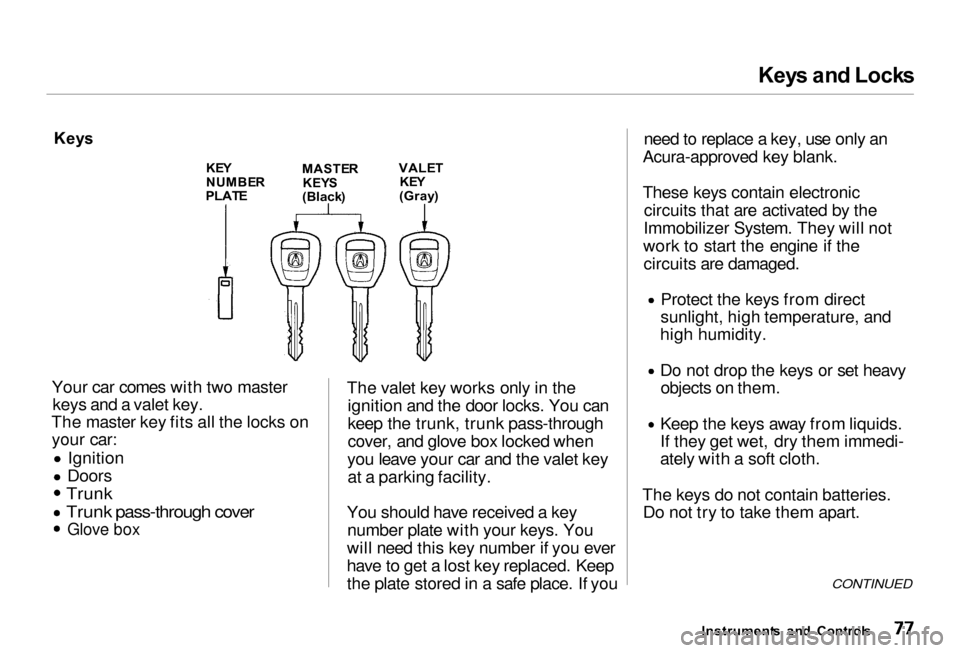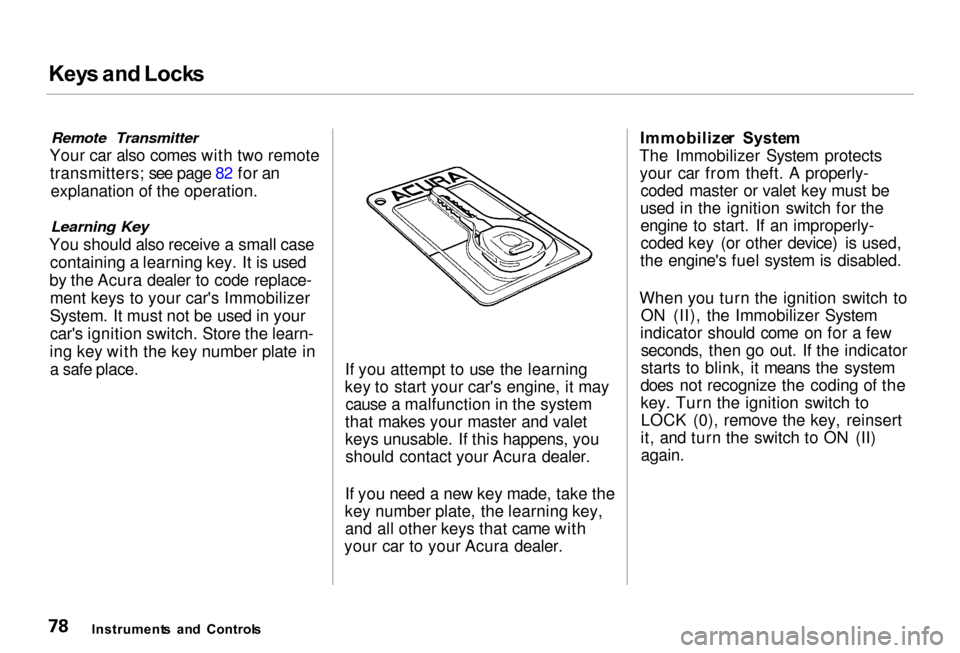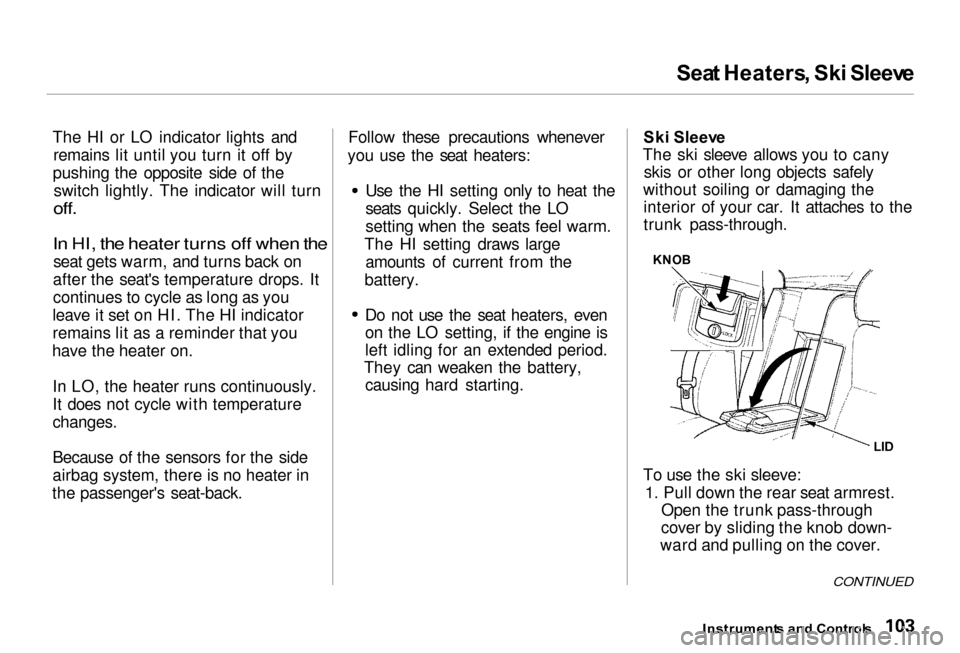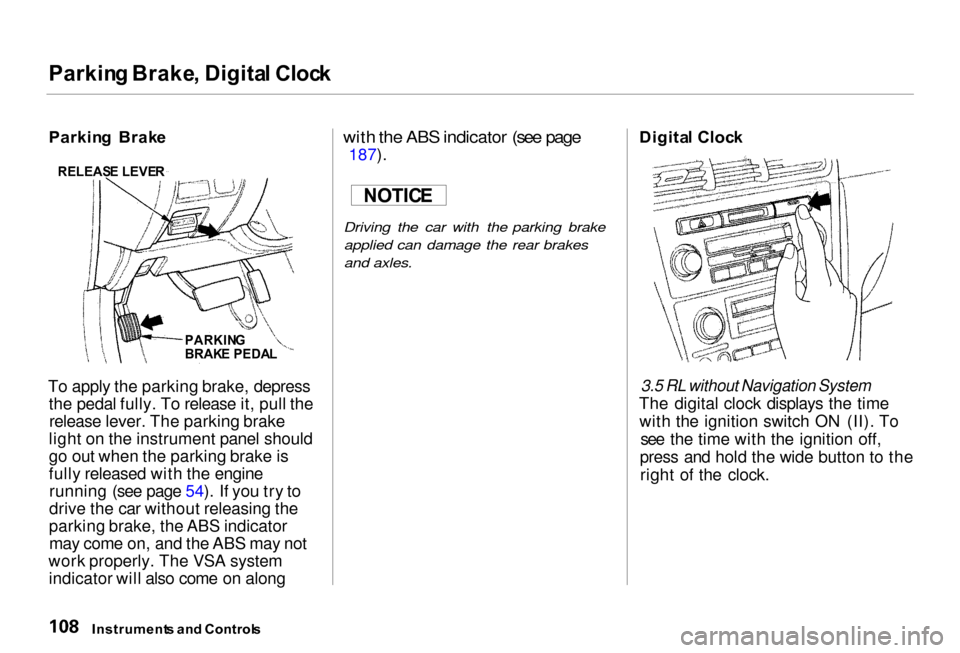engine Acura RL 2000 3.5 User Guide
[x] Cancel search | Manufacturer: ACURA, Model Year: 2000, Model line: RL, Model: Acura RL 2000Pages: 330, PDF Size: 4.53 MB
Page 80 of 330

Key
s an d Lock s
Key s
KEY
NUMBE R
PLAT E
MASTE
R
KEY S
(Black )
VALE
T
KE Y
(Gray )
Your car comes with two master keys and a valet key.
The master key fits all the locks on your car: Ignition
Doors
Trunk
Trunk pass-through cover
Glove box
The valet key works only in the
ignition and the door locks. You can
keep the trunk, trunk pass-through
cover, and glove box locked when
you leave your car and the valet key at a parking facility.
You should have received a key number plate with your keys. You
will need this key number if you ever
have to get a lost key replaced. Keep
the plate stored in a safe place. If you need to replace a key, use only an
Acura-approved key blank.
These keys contain electronic circuits that are activated by the
Immobilizer System. They will not
work to start the engine if the circuits are damaged. Protect the keys from direct
sunlight, high temperature, and
high humidity. Do not drop the keys or set heavy
objects on them. Keep the keys away from liquids.
If they get wet, dry them immedi-
ately with a soft cloth.
The keys do not contain batteries. Do not try to take them apart.
CONTINUED
Instrument s an d Control s
Page 81 of 330

Key
s an d Lock s
Remote Transmitter
Your car also comes with two remote transmitters; see page 82 for an explanation of the operation.
Learning Key
You should also receive a small case containing a learning key. It is used
by the Acura dealer to code replace- ment keys to your car's Immobilizer
System. It must not be used in your
car's ignition switch. Store the learn-
ing key with the key number plate in a safe place. If you attempt to use the learning
key to start your car's engine, it may cause a malfunction in the system
that makes your master and valet
keys unusable. If this happens, you should contact your Acura dealer.
If you need a new key made, take the
key number plate, the learning key, and all other keys that came with
your car to your Acura dealer. Immobilize
r Syste m
The Immobilizer System protects your car from theft. A properly- coded master or valet key must be
used in the ignition switch for the engine to start. If an improperly-
coded key (or other device) is used,
the engine's fuel system is disabled.
When you turn the ignition switch to ON (II), the Immobilizer System
indicator should come on for a few seconds, then go out. If the indicator
starts to blink, it means the system
does not recognize the coding of the
key. Turn the ignition switch to LOCK (0), remove the key, reinsert
it, and turn the switch to ON (II)
again.
Instrument s an d Control s
Page 82 of 330

Key
s an d Lock s
The system may not recognize your key's coding if another immobilizer
key or other metal object is near theignition switch when you insert the
key. To make sure the system
recognizes the key code: Do not keep other immobilizer
keys on the same key ring. Use a plastic or leather key fob,
not metal. Keep other keys away from your
vehicle's key and the ignition switch while trying to start the
engine.
If the system repeatedly does not
recognize the coding of your key,
contact your Acura dealer.
This indicator will also blink several times when you turn the ignitionswitch from ON (II) to ACCESSORY (I) or LOCK (0). Do not attempt to alter this system
or add other devices to it. Electrical
problems could result that may make
your car undriveable.
If you have lost your key and you
cannot start the engine, contact your
Acura dealer. As required by the FCC:
This device complies with Part 15 of the
FCC rules. Operation is subject to the
following two conditions: (1) This device may not cause harmful interference, and (2) this device must accept any
interference received, including
interference that may cause undesired operation.
Changes or modifications not expressly
approved by the party responsible for compliance could void the user's
authority to operate the equipment.
This device complies with Industry
Canada Standard RSS-210.
Operation is subject to the following two
conditions: (1) this device may not cause
interference, and (2) this device must accept any interference that may cause undesired operation of the device.
Instrument s an d Control s
Page 83 of 330

Key
s an d Lock s
Ignitio n Switc h
The ignition switch is on the right side of the steering column. It has
four positions: LOCK (0)
ACCESSORY (I)
ON (II)
START (III) LOC
K (0 ) — You can insert or
remove the key only in this position.
To switch from ACCESSORY to LOCK, you must push the key inslightly as you turn it. The shift lever
must also be in Park. The anti-theft
lock will lock the steering column
when you remove the key.
If the front wheels are turned, the
anti-theft lock may sometimes make
it difficult to turn the key from
LOCK to ACCESSORY. Firmly turn
the steering wheel to the left or to
the right as you turn the key.
ACCESSOR Y (I ) — In this position,
you can operate the audio system and the cigarette lighter.
O N (II ) — This is the normal key
position when driving. All features
and accessories on the car are usable.
Several of the lights on the instru-
ment panel come on as a test when
you turn the ignition switch from ACCESSORY to ON.
STAR T (III ) — Use this position
only to start the engine. The switch
returns to ON (II) when you let go of
the key.
The engine will not start if the Immobilizer System does not
recognize the key's coding (see page 78).
You will hear a reminder beeper if you leave the key in the ignition switch in the LOCK (0) or
ACCESSORY (I) position and open the driver's door. Remove the key to
turn off the beeper.
Instrument s an d Control s
Page 106 of 330

Sea
t Heaters , Sk i Sleev e
The HI or LO indicator lights and remains lit until you turn it off by
pushing the opposite side of the switch lightly. The indicator will turn
off.
In HI, the heater turns off when the
seat gets warm, and turns back on
after the seat's temperature drops. It
continues to cycle as long as you
leave it set on HI. The HI indicator
remains lit as a reminder that you
have the heater on.
In LO, the heater runs continuously.
It does not cycle with temperature
changes.
Because of the sensors for the side
airbag system, there is no heater in
the passenger's seat-back. Follow these precautions whenever
you use the seat heaters:
Use the HI setting only to heat the
seats quickly. Select the LO
setting when the seats feel warm.
The HI setting draws large amounts of current from the
battery.
Do not use the seat heaters, even
on the LO setting, if the engine is
left idling for an extended period.
They can weaken the battery, causing hard starting. Sk
i Sleev e
The ski sleeve allows you to cany skis or other long objects safely
without soiling or damaging the interior of your car. It attaches to the
trunk pass-through.
KNO B
To use the ski sleeve: 1. Pull down the rear seat armrest. Open the trunk pass-through
cover by sliding the knob down-
ward and pulling on the cover.
Instrument s an d Control s
LI
D
CONTINUED
Page 111 of 330

Parkin
g Brake , Digita l Cloc k
Parkin g Brak e
To apply the parking brake, depress the pedal fully. To release it, pull therelease lever. The parking brake
light on the instrument panel should
go out when the parking brake is
fully released with the engine running (see page 54). If you try to
drive the car without releasing the
parking brake, the ABS indicator may come on, and the ABS may not
work properly. The VSA system indicator will also come on along
with the ABS indicator (see page
187).
Driving the car with the parking brake applied can damage the rear brakes
and axles.
Digita
l Cloc k
3.5 RL without Navigation System
The digital clock displays the time with the ignition switch ON (II). To see the time with the ignition off,
press and hold the wide button to the right of the clock.
Instrument s an d Control s
RELEAS
E LEVE R
PARKIN G
BRAK E PEDA L
NOTIC
E
Page 123 of 330

Climat
e Contro l Syste m
The automatic climate control system in your Acura picks the
proper combination of air condi-
tioning, heating, and ventilation to
maintain the interior temperature
you select. The system also adjusts the fan speed and air flow levels.
The direction of air flow from the vents in the center and each side ofthe dashboard is adjustable. Move
the tab in the center of each vent up- and-down and side-to-side.
The side vents can be opened and closed with the dials next to them.
In the rear seat, you can also adjust
the ventilation when the climate con-
trol system is on (see page 132 ).
CENTE
R VENT S
The climate control system draws air through the exterior vents at the
bottom of the windshield. Keep
these vents clear of leaves and other
debris.
SID
E VENT S
For the climate control system to
provide heating and cooling, the engine must be running.
Comfor t an d Convenienc e Feature s
Page 168 of 330

Before
Driving
Before you begin driving your Acura,
you should know what gasoline to use, and how to check the levels of
important fluids. You also need to
know how to properly store luggage or packages. The information in this
section will help you. If you plan to
add any accessories to your car,
please read the information in this section first. Break-in Period.............................. 166
Gasoline.......................................... 166
Service Station Procedures .......... 167 Filling the Fuel Tank................. 167Opening the Hood..................... 168
Oil Check................................ 169
Engine Coolant Check.......... 170
Fuel Economy................................ 171 Car Condition............................. 171
Driving Habits............................ 171
Accessories and Modifications.... 172 Carrying Cargo.............................. 174
Before Drivin g
Page 169 of 330

Break-i
n Period , Gasolin e
Break-i n Perio d
Help assure your car's future
reliability and performance by paying
extra attention to how you drive
during the first 600 miles (1,000 km).
During this period:
Avoid full-throttle starts and rapid
acceleration.
Avoid hard braking. New brakesneed to be broken-in by moderate
use for the first 200 miles (300
km).
You should follow these same re- commendations with an overhauled
or exchanged engine, or when the
brakes are relined.
Gasolin e
Your Acura is designed to operate on premium unleaded gasoline with apump octane number of 91 or higher.
If you are unable to find premium
unleaded gasoline, you may substi-
tute an unleaded regular gasoline.
The engine will compensate for the lower octane, but you may notice aslight decrease in power as a result.
We recommend gasolines containing detergent additives that help prevent
fuel system and engine deposits.
Using gasoline containing lead will
damage your car's emissions
controls. This contributes to air
pollution. In Canada, some gasolines contain
an octane-enhancing additive called
MMT. If you use such gasolines,
your emissions control system performance may deteriorate andthe Malfunction Indicator Lamp on
your instrument panel may turn on. If this happens, contact your
authorized Acura dealer for service.
Befor e Drivin g
Page 170 of 330

Servic
e Statio n Procedure s
Fillin g th e Fuel Tank
1. Because the fuel fill cap is on the
driver's side of the car, park with
that side closest to the service
station pumps.
2. Open the fuel fill door by pulling
on the handle to the left of the
driver's seat.
FUE L FIL L CA P 3. Remove the fuel fill cap slowly.
You may hear a hissing sound as
pressure inside the tank escapes.
Place the cap in the holder on the
fuel fill door.
4. Stop filling the tank after the fuel
nozzle automatically clicks off. Do
not try to "top off" the tank, leave
some room for the fuel to expand
with temperature changes.
Your car has an on-board refueling
vapor recovery system to help
keep fuel vapors from going into
the atmosphere. If the fuel pump
keeps clicking off even though thetank is not full, there may be a
problem with this system. Consult
your dealer.
CONTINUED
Befor e Drivin g
Pul
l
Gasoline is highly flammable
and explosive. You can be
burned or seriously injured
when handling fuel.
Stop the engine and keep
heat, sparks, and flame away.
Handle fuel only outdoors.
Wipe up spills immediately.